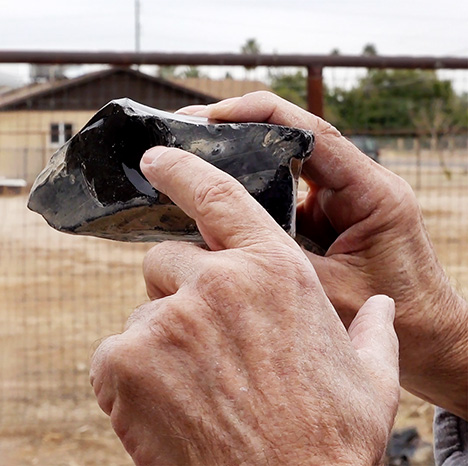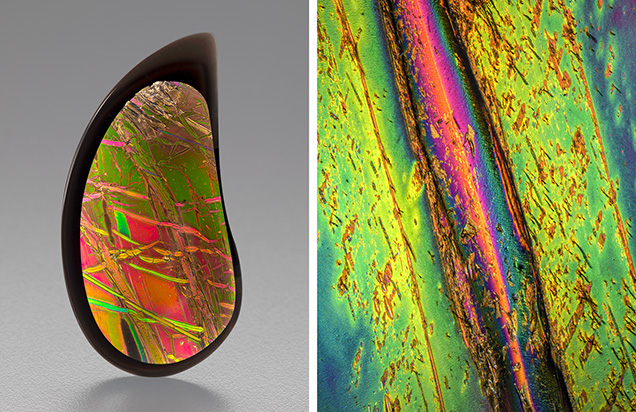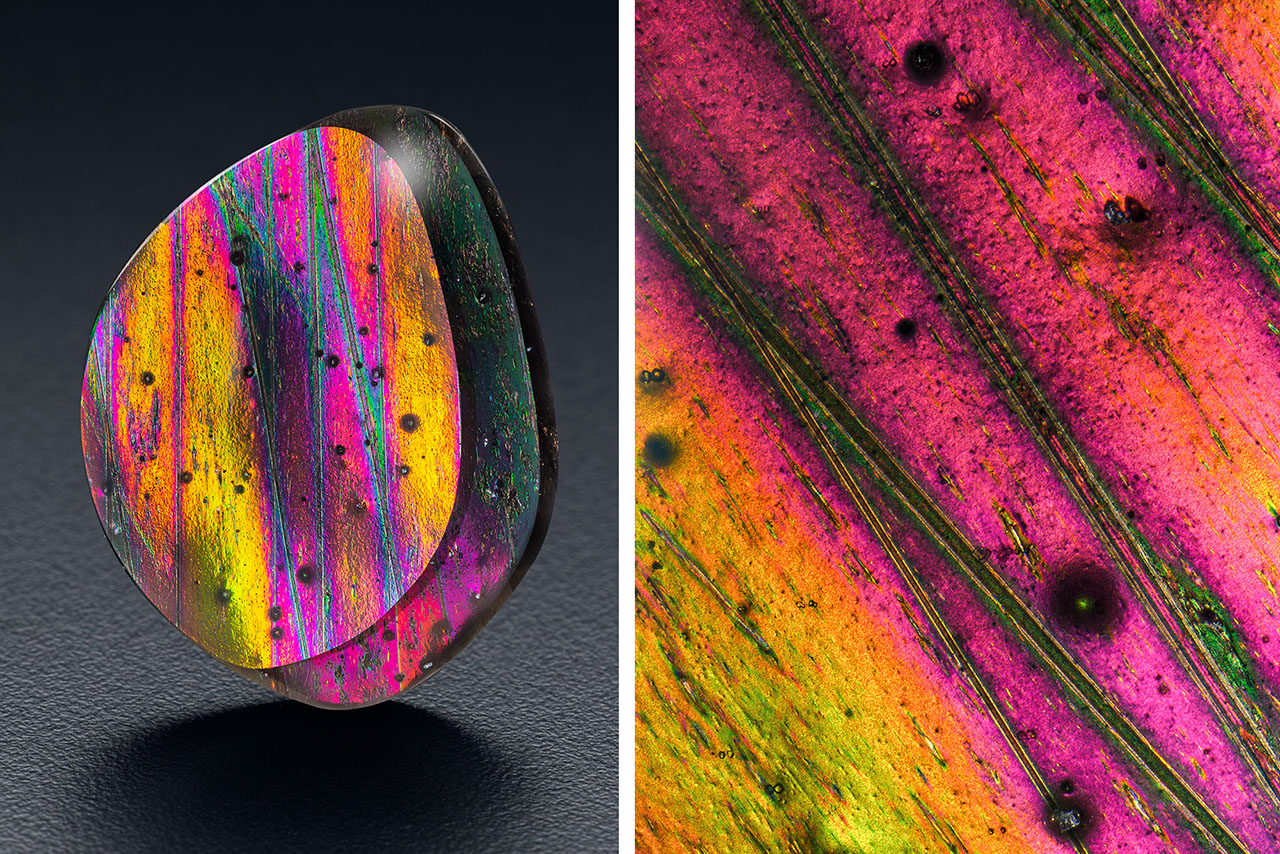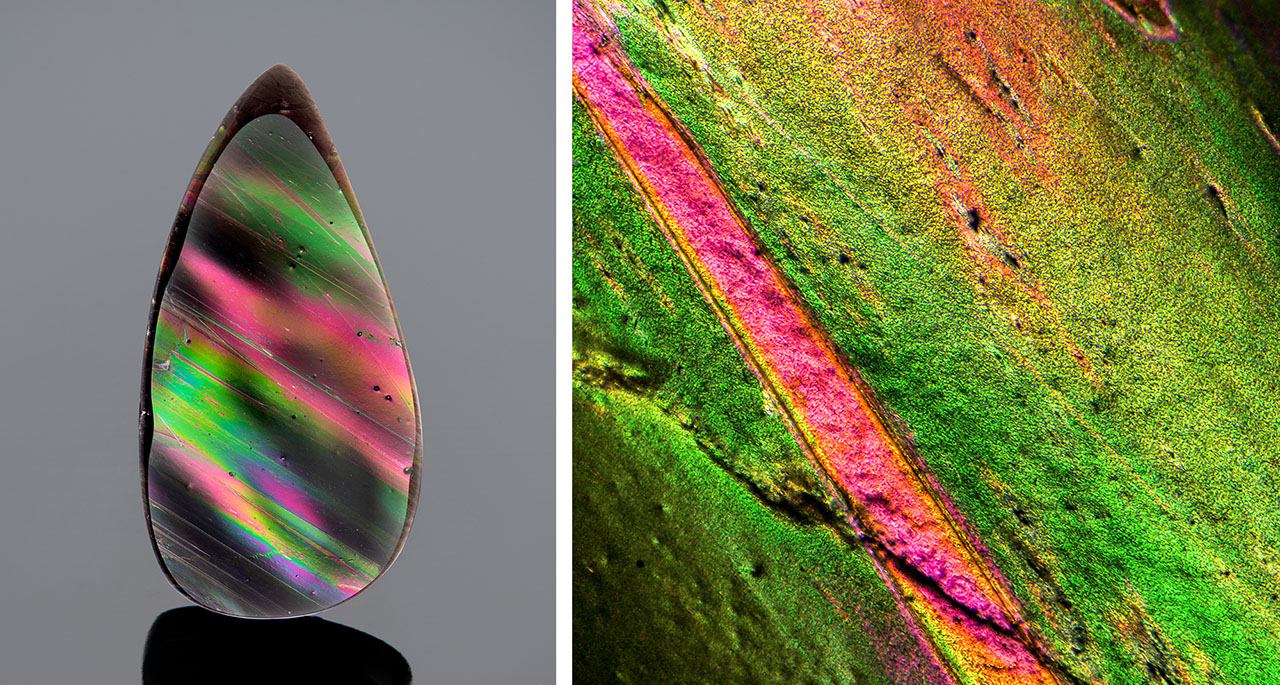Fire Obsidian’s Beguiling Spectrum


Tom Dodge (figure 1) has come to be associated with the natural glass known as “fire obsidian.” Since 2014 he has championed its vibrant beauty. He has also mined for it, for weeks at a time, at a private property owned by Emory Coons in the desolate Glass Buttes region of central Oregon in the United States (figure 2). This volcanic terrain is easier to mine in late spring and summer.

Dodge has spent years learning how to best fashion the material, first forming and then delicately polishing the glass at his lapidary workshop in Phoenix, Arizona. Although it is challenging to visualize where the colors may lie in the rough, he has developed an affinity for locating iridescence in the raw material (figure 3). Interviewed at his lapidary studio in Phoenix in 2022, Dodge noted that even among his carefully selected chunks of glass, there are countless samples that simply do not show the effect, even after lapidary work. Others contain reflective layers that are not flat—when fashioned, they appear to billow and ripple like a wind-blown flag.
Due to these nuances, which change from sample to sample, he takes time to carefully trim, fashion, and polish the pieces. He uses diamond abrasive cabochon-cutting equipment and optical-grade cerium oxide polishing powder to reveal vivid spectrums of undulating color and depth. While the exterior shapes he produces are large oval cabochons or tablets, the patterns and colors experienced in any piece, with proper lighting and orientation, are never replicated.
FIRE OBSIDIAN
“Obsidian, a natural volcanic glass, is not particularly rare,” Dodge said, demonstrating how to shine a light on samples of his most vibrant cabochons. “The material is widespread across the world. Most of it comes from the Western United States, but [it can be found] anywhere there are volcanic terrains. In North America, Mexico, and South America, there is an abundance.”
Fire obsidian, so named for its vivid spectrum of colors, is rare and so far has been found in only one site within the Glass Buttes region of central Oregon. A rhyolitic dome field, Glass Buttes has vast quantities of obsidian in various patterns and varieties. But only a tiny percentage of it is suitable for fire obsidian.
Dodge differentiates fire obsidian from so-called rainbow (or sheen) obsidian, which exhibits broad, mostly even bands of pastel colors. Much of that material comes from the Mexican state of Jalisco and from northern California (C. Ma et al., “Micro-analytical study of the optical properties of rainbow and sheen obsidian,” Canadian Mineralogist, Vol. 39, 2001, pp. 57–71). Obsidian typically appears black or brown and is generally translucent in smaller pieces. Impurities in the glass such as magnetite (an iron oxide) or manganese give the material its natural bodycolor.
Beyond the bodycolor, though, it is the sudden flashes of vivid iridescent colors that give fire obsidian its distinctive appeal.
“This is caused by a thin-film interference, when one type of the obsidian is in contact with another type of obsidian, such as an iron-rich obsidian. This contact zone interacts with light as light reflects from the surface, enters the material, and is in part bent due to the optical characteristics of glass—its angle of refraction,” said Dodge. “This phenomenon resembles the color effect you see in soap bubbles, oil on water, or windshield wiper fluid in contact with the windshield... So when those two reflected portions of light come back to your eye, you’ll see red, you’ll see green. And if you move the stone or change the angle of the light, some areas of that stone will reveal or change the perceived colors. There must be two overlying layers that have a different refractive index, which produces this remarkable iridescence.”
Dodge also noted that the flow bands of obsidian that exhibit color are very thin—between 300 and 700 nm (C. Ma et al., “The origin of color in ‘fire’ obsidian,” Canadian Mineralogist, Vol. 45, 2007, pp. 551–557)—which means that stones must not be polished to such an extent that the color spectrum is removed. When cut properly, often paralleling the flow structure in the glass, the optical effect is both sudden and stunning. Additionally, the flow structures give rise to unusual patterns that can resemble blades of grass, sections of ribbon, branches, or sharp blades.
“They are just intrinsically beautiful. The more you look at them, the more they have to offer—the more you will see. I still spend time with some stones that I cut five years ago, and I see things that I didn’t see before.”
GEMOLOGY OF FIRE OBSIDIAN
The gemological properties of fire obsidian from Glass Buttes, Oregon, are quite consistent with those of nonphenomenal obsidian. The refractive index measured on one sample was 1.469, with a hydrostatic specific gravity of 2.36. The material was inert to both long- and short-wave UV. Microscopic examination of the material revealed distinct, paper-thin dark layers as the source of the vibrant iridescence. These layers are composed primarily of nano-size crystals of magnetite, which result in thin-film interference colors (C. Ma et al., 2007).
When illuminated properly with diffuse reflected light, a history of the once molten glass is revealed in the vibrant patterns showing flow structures that have obviously been stretched, sheared, and compressed in ways that only a molten material can be. These structures are preserved in the solidified glass, an amorphous material, and revealed only through human intervention with a keen eye and some basic lapidary equipment.
The photo gallery below shows images of fire obsidian fashioned by Dodge. Because of the directionality and highly reflective character of glass, fire obsidian is often photographed immersed in liquid to reduce surface light reflections. The photomicrography reveals numerous flow structures and vibrant patterns of thin-film interference resulting from layers of nano-size magnetite particles.
The photos are by Robert Weldon, and the accompanying photomicrographs are by Nathan Renfro. All specimens are from the collection of Tom Dodge.













